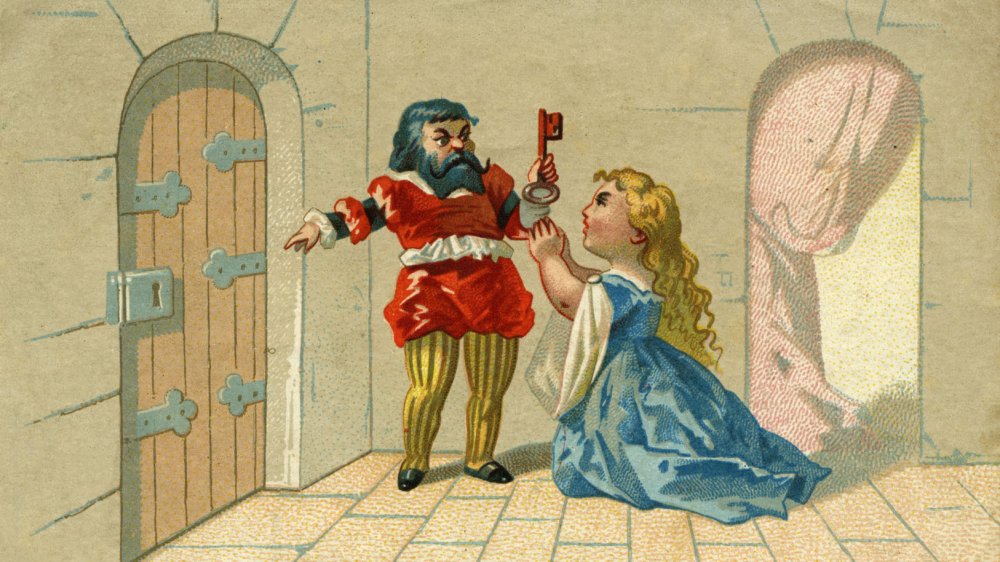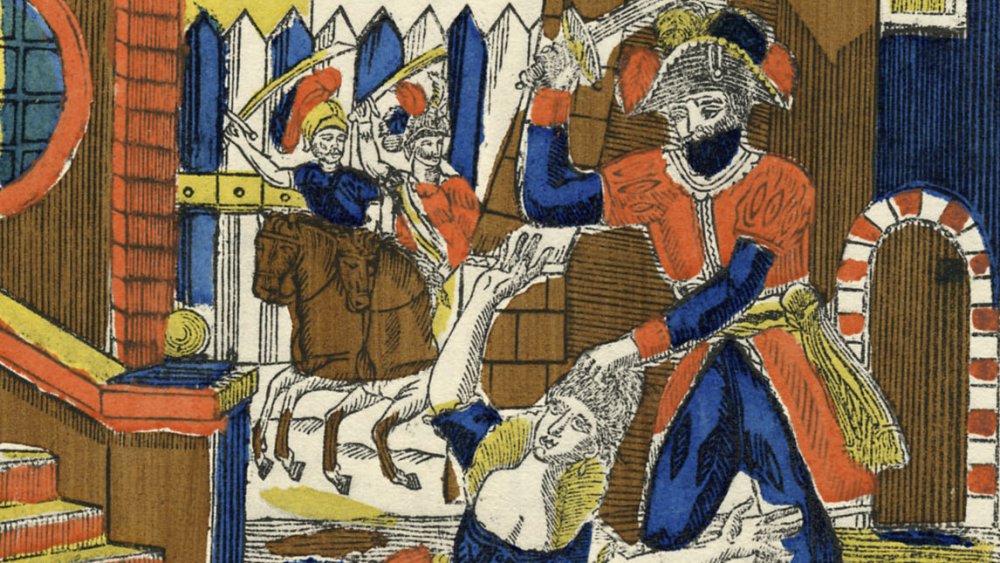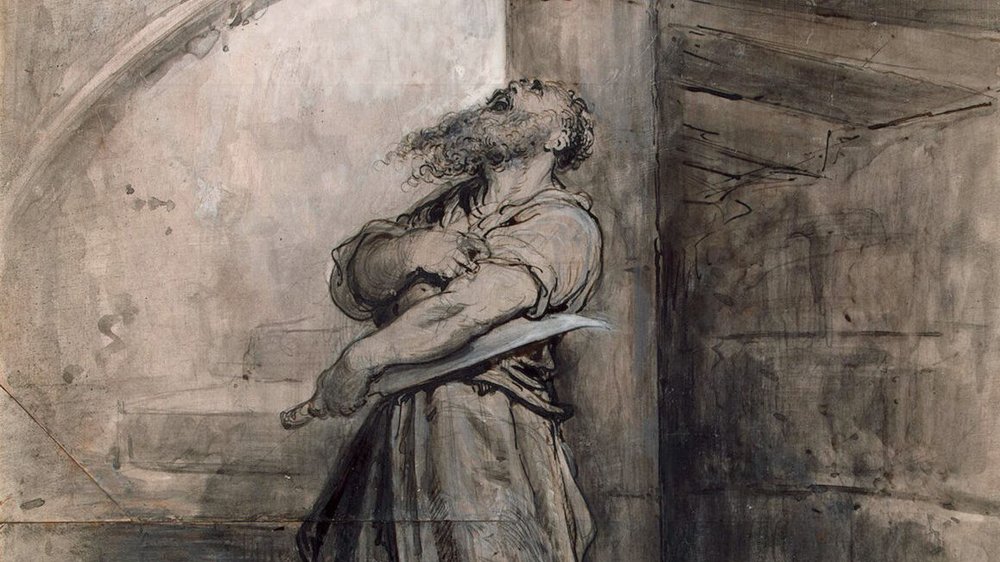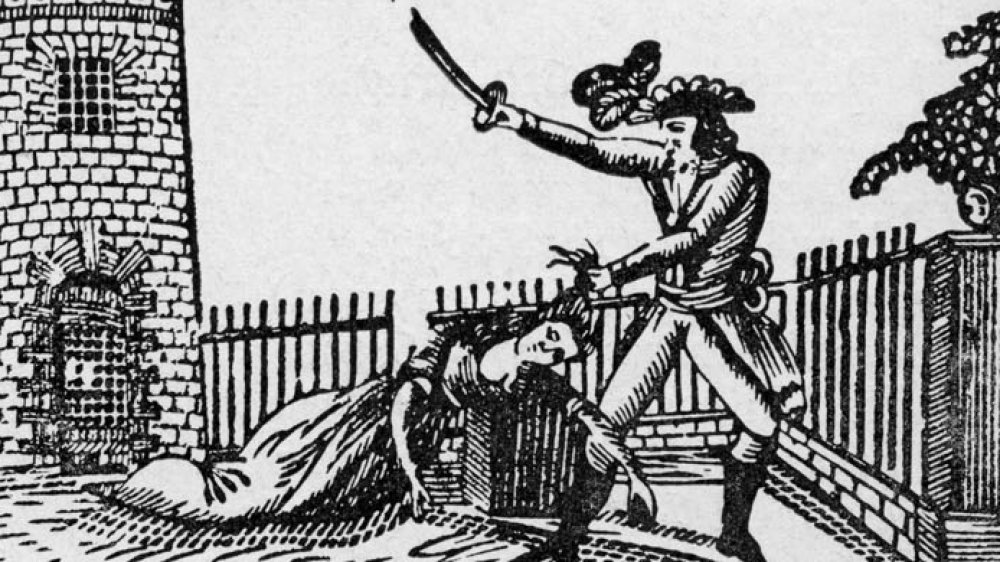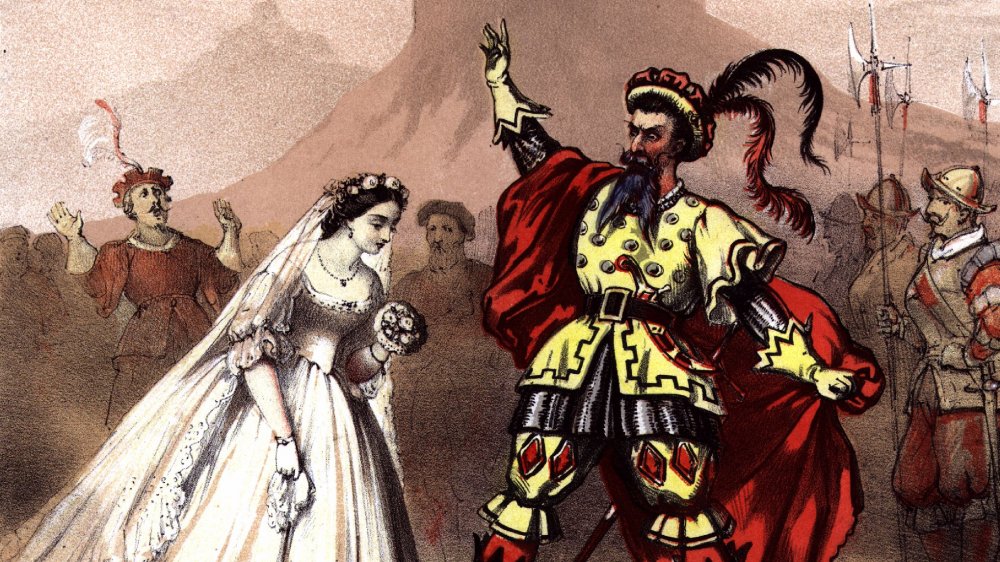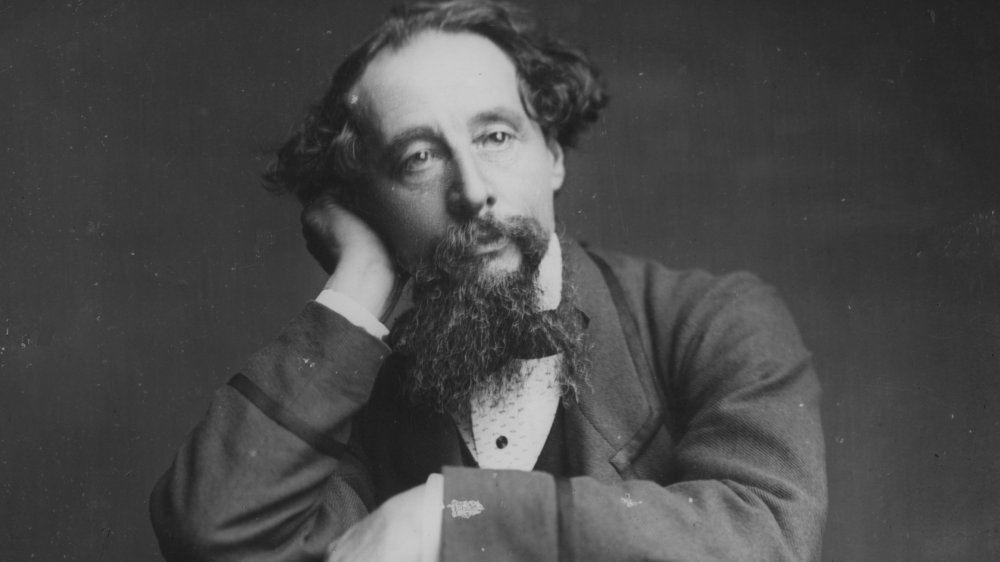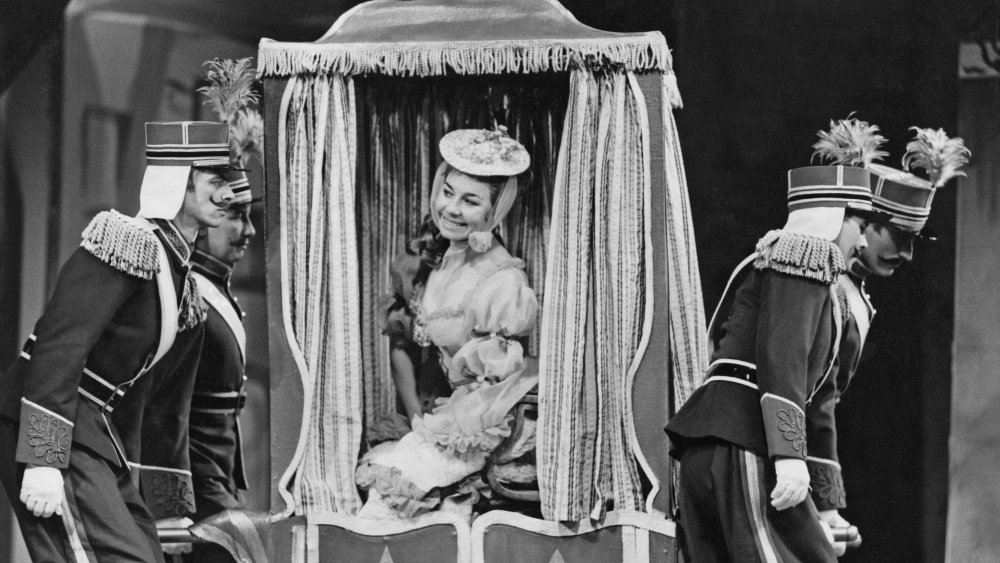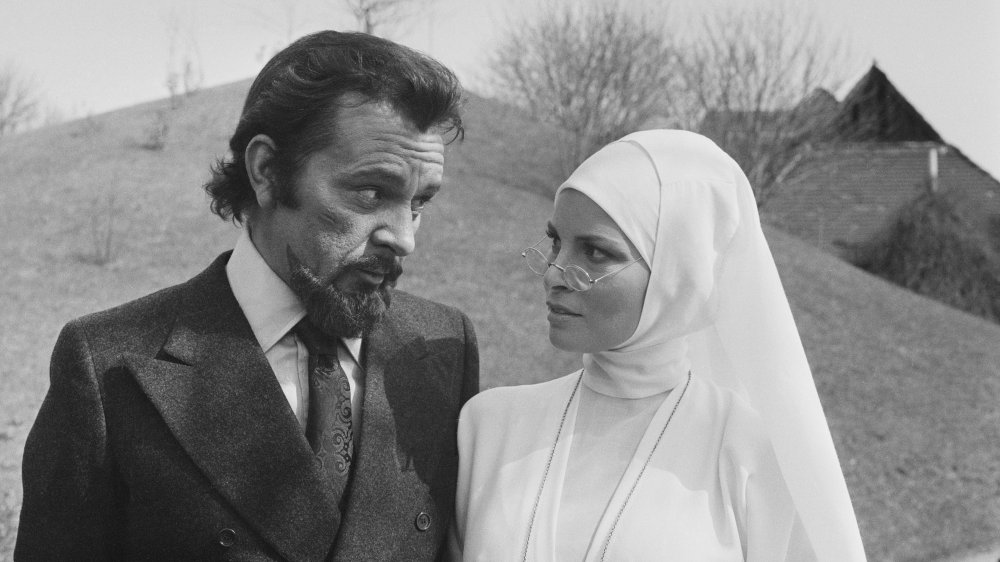The Legend Of Bluebeard Finally Explained
The folktales of old are known for their spooky castles, nefarious foes, forbidden rooms, and cunning protagonists. The legend of Bluebeard has all of these elements. The story, which tells of a mysterious aristocrat who kills the women he weds as a punishment for their curiosity about him, was first recorded in France in the 1600s. It was likely inspired by certain murderous nobles who terrorized the country during the Middle Ages, although versions of it exist in the folklore of cultures around the world. Over the years, it has been preserved through the writings of notable authors such as Charles Perrault and the Brothers Grimm. It has also been adapted into a variety of bone-chilling works, including short stories, novels, operas, and films.
Are you dying to learn the truth about Bluebeard, just as his many ex-wives were? If so, read on for the facts on the infamous villain.
The folktale was first published by Charles Perrault
No one knows when the Bluebeard folktale was told for the first time. However, the first printed version we know of is "La Barbe bleue," a short story published by French author Charles Perrault in his 1697 compilation Histoires ou contes du temps passé. According to this tale, "Blue Beard" is an exceedingly wealthy man whose blue facial hair is so ugly that it repels all potential brides. In order to improve his public image, he invites several young women to his country house for a lavish week of festivities. One of the women is so impressed that she agrees to marry him.
Eventually, Blue Beard tells his wife that he must depart for a business trip. He urges her to explore his manor in his absence and gives her a key ring so that she may do so. However, there is a caveat: She must not use "the key to the closet at the end of the great hall on the ground floor."
Overtaken by curiosity, the woman opens the forbidden door. Upon entering the room, she finds herself surrounded by the bloodied corpses of several women: Blue Beard's ex-wives, all of whom were murdered by him for their disobedience. When Blue Beard returns, he discovers that the woman went against his orders and plans to add her to his collection. Thankfully, her brothers arrive at the manor in time to slay him, freeing her from his wrath.
The legend of Bluebeard may have been inspired by Gilles de Rais
Historians have long speculated about the inspiration for Perrault's story. Some believe that his Bluebeard was modeled after Gilles de Rais, referred to by Encyclopedia Britannica as "history's first serial killer."
At first, de Rais was considered an upstanding citizen. As a young man, he fought in the Hundred Years' War. In 1429, the dauphin asked him to accompany Joan of Arc in battle. That same year, he was appointed as marshal of France. After Joan of Arc's death, however, he fell into a dangerous lifestyle. He spent his money carelessly and eventually sold family lands to prevent himself from being overwhelmed by debt, a decision that created strife between him and his relatives. As his financial stability became increasingly threatened, he turned to the occult in an attempt to redirect his fate.
Around this time, reports of children going missing around de Rais' castles were beginning to surface. In 1437, his servants were spotted disposing of the bodies of dozens of children. However, no formal accusations against him were made, given that the lower-class families who had lost children were afraid of incurring the powerful marshal's wrath. In 1440, de Rais exposed himself as a violent man when he kidnapped a priest in an unrelated dispute. He was then brought to court and tried for several offenses, including the murder of over 100 children. Under threat of torture, he confessed to ordering the kidnapping and murder of all these youths.
Conomor the Accursed might also have inspired Bluebeard
Another likely model for Bluebeard is Conomor the Accursed, who ruled Brittany in the mid-sixth century. According to Marina Warner's From the Beast to the Blonde: On Fairy Tales and Their Tellers, Conomor married a young woman named Triphine, the daughter of a count, late in his life. After she became pregnant, ancient texts claim, Triphine was visited by several ghosts who revealed themselves to be the spirits of Conomor's many ex-wives. They told her that Conomor had murdered them before they could give birth and warned her that the same fate would soon come to her.
Triphine tried to escape the castle, but Conomor pursued her, caught her, and beheaded her. It is said that in a miraculous twist of fate, St. Gildas, who lived in the area, came across her body in the woods and restored her to life. Then, together, they confronted Conomor at his castle. The walls came crumbling down atop him in a spectacular show of poetic justice. Since then, several churches have been built in Triphine's honor.
Not only is Conomor linked to the Bluebeard tale, but according to local folklore, he also might have been a "bisclavret," or werewolf.
Bluebeard is preceded by a tale from Arabian Nights
Although the Bluebeard folktale as we know it today originated in France, the legend does have a Middle Eastern precedent. Long before Charles Perrault sat down to write his book, the motif of the forbidden room was featured in "The History of Agib" from Arabian Nights.
In this story, a prince named Agib embarks on a voyage and finds himself lost at sea. Eventually, he arrives at a castle, where he is greeted by ten men, strangely "all blind of the right eye," and 40 beautiful ladies. The ladies give him the keys to 100 doors but tell him that he may never enter the castle's mysterious "golden door." Naturally, he caves in to his curiosity and opens the door despite the warning. When he does, he sees a beautiful black horse. He grabs onto its bridle to get a look at it, but the horse shakes him off and swats him with his tail, knocking out his eye. He then realizes that all the half-blind men experienced the same unfortunate turn of events.
The Brothers Grimm put their own spin on Bluebeard
In the 19th century, the Bluebeard story caught the attention of famous folklorists the Brothers Grimm, who published an adaptation of it in their 1812 collection Grimm's Fairy Tales. In their version, the woman is instinctively wary of Bluebeard from the start and tells her brothers before she moves into his castle, "If you hear me scream, leave everything standing or lying where you are, and come to my aid." Thus, when Bluebeard tries to kill her and she yells for them, they are ready to rescue her.
The Brothers Grimm presented another variation on the Bluebeard tale in "Fitcher's Bird." In this story, the Bluebeard figure is a wealthy sorcerer who kidnaps the beautiful eldest daughter of a country family. When he brings her to his house, he gives her an egg and orders her to carry it with her at all times. He also tells her explicitly that if she enters his forbidden room, she will die. Upon entering the room, she drops the egg out of shock, bloodying it. The sorcerer notices and, true to his word, murders her. Then he kidnaps the woman's sister, and she ultimately meets the same fate. When he finally moves on to the youngest sister, she puts the egg aside before exploring the house, and thus her "betrayal" is never discovered. She calls for her brothers and relatives, and they burn down the sorcerer's house — and the sorcerer with it.
There's an Italian variation called Silvernose
Variants of the Bluebeard legend exist in many cultures. For an example, look no further than the Italian folktale "Silvernose." According to an essay by Terri Findling, the story shares elements with both Perrault's "Blue Beard" and the Brothers Grimm's "Fitcher's Bird." Yet its villain is not simply a nobleman but the Devil disguised as one — and instead of a blue beard, he has a silver nose.
The story begins when the Devil knocks on the door of a widowed washerwoman and offers her eldest daughter a job at his house. Upon her arrival, he gives her a ring of keys and tells her that she may enter any room in the house but one. Then he puts a rose in her hair while she is sleeping. In the morning, she chooses to unlock the forbidden door and finds a fiery portal to Hell on the other side. She slams the door shut, but the rose in her hair is singed. When the Devil sees this sign of her transgression, he throws her into the room as a punishment.
Eventually, he hires the washerwoman's middle daughter, and she meets the same fate. The youngest daughter notices the rose, puts it aside before exploring the house, and places it back into her hair when she sleeps, tricking the Devil into thinking she has obeyed him. While his guard is down, she returns to the portal and rescues her sisters once and for all.
There's also a version known as The Robber Bridegroom
Also similar to "Blue Beard" and "Fitcher's Bird," notes Findling in her essay, is the tale of "The Robber Bridegroom" or "Mr. Fox," which can be found in the folklore of various European countries. In this story, a young woman is set to marry a mysterious, wealthy man named Mr. Fox. When she realizes that she has never seen his home, she sneaks off to explore it. In the woods, she finds a gate that reads, "Be bold." She passes through and arrives at Mr. Fox's mansion, the entrance to which is inscribed, "Be bold, be bold." Inside, she finds a staircase with a sign that states, "Be bold, be bold, but not too bold." Ultimately, she arrives at a door with an even more frightening warning: "Be bold, be bold, but not too bold, lest your heart's blood should run cold."
When the woman opens the door, she is shocked to find a chamber filled with the dismembered corpses of Mr. Fox's victims. Just as she is about to run, she hears Mr. Fox approaching and is forced to hide inside the room. She watches in fear as Mr. Fox drags in a new woman and cuts her up. Then she grabs the woman's severed hand and pockets it as evidence. The next day, at a feast for the soon-to-be bride and groom, she confronts Mr. Fox and throws the bloodied hand at him. The bridal party cuts him up in retaliation.
Bluebeard's moral is debatable
The story of Bluebeard is rather grisly, ending with a dark secret and several corpses. In an attempt to explain the thematic significance of the bloodshed, Perrault included a moral at the end of his account: "Curiosity, in spite of its appeal, often leads to deep regret. To the displeasure of many a maiden, its enjoyment is short lived. Once satisfied, it ceases to exist, and always costs dearly." Many modern theorists, however, have argued that Perrault's warning does not truly capture the essence of the original legend.
In her essay "Madam Has a Word to Say," scholar Margrét Snæfríður Jónsdóttir argues that the protagonist's curiosity actually functions as a protective measure, given that she would be married to a murderer whether or not she looked in the forbidden room. Read in this light, the story actually "[encourages] women not to follow patriarchal rules without question." Author Theodora Goss puts it more simply in her reflection on the tale: "Make sure you know whom you're marrying, because your husband may be a serial killer."
The legend of Bluebeard became reality in the 1920s
Unfortunately, the fiction of the Bluebeard tale became fact in the 1920s, when a man named James Watson — nicknamed "Bluebeard" by the press — went on a wife-killing spree that stretched across America. According to the Los Angeles Times, Watson used enticing personal ads to reel in potential bride-victims from all over the country, under a variety of aliases. Sometimes, he was a banker. Other times, he was a federal agent or a traveling salesman. Always, he had a career that would require him to go on regular "business trips," allowing him to live his double life of polygamy and murder.
Watson's crimes remained under the radar until one of his wives, Katherine Wombacher, became suspicious of his lifestyle and hired a detective agency to follow him. Eventually, the detective team found him and seized his belongings. Among them were an array of love letters and marriage licenses, in addition to stolen women's jewelry.
While he was in custody, Watson admitted to killing at least seven of his wives. According to an archived article from the San Francisco Chronicle, he employed a variety of gruesome methods to carry out these deeds, ranging from drowning to smothering to using a sledgehammer.
The legend of Bluebeard has inspired numerous authors
Due to its simplicity and universal themes, the Bluebeard folktale has served as a template for numerous reimaginings. One of these is Charles Dickens' "Captain Murderer," published in 1860. In the story, the titular character, whom Dickens refers to as "an offshoot of the Bluebeard family," kills and eats each of his wives. He is ultimately defeated when a woman whose sister was murdered by Bluebeard offers her hand in marriage to him and swallows poison before he consumes her.
In 1979, Angela Carter published the short story collection The Bloody Chamber, described as an "updating of the classic European fairy tales" by The New Yorker. The titular story in this book is a version of the Bluebeard tale. In Carter's vision, the woman is a 17-year-old girl, and Bluebeard is a French marquis who is both brutal and patronizing as a lover. Carter's heroine discovers Bluebeard's room of corpses and is almost murdered, just as Perrault's was. Yet she is ultimately rescued by her mother rather than by her brothers.
In 1987, Kurt Vonnegut published a novel titled Bluebeard. As stated in a review from The New York Times, its protagonist, a painter named Rabo Karabekian, is not a Bluebeard figure in any traditional sense: He does not have a string of ex-wives, and he is not a serial murderer. However, he does harshly forbid his girlfriend from entering the potato barn he uses as an art studio.
Bluebeard has been turned into multiple operas
Not only has the Bluebeard tale been adapted for the page — it has also been reinterpreted for the stage. The story has been turned into four operas, all of which are still being performed today.
The first opera to bring the folktale to life was Raoul Barbe-bleue, composed by André Grétry in 1789. Opera news site Bachtrack describes it as a more lighthearted spin on the legend, mixing moments of humor with suspense. Next was Jacques Offenbach's Barbe-bleue, which premiered in 1866. Offenbach's adaptation is just as comedic as Grétry's but with an added political twist: According to the Opera de Lyon, Offenbach's portrayal of Bluebeard is "a caricature of the parvenus of [France's] Second Empire."
In 1907, Paul Dukas presented a more dramatic adaptation of the Bluebeard story with his opera Ariane et Barbe-Bleue. According to critic Raymond Tuttle, this version depicts Bluebeard as a serial kidnapper rather than a killer. His many wives are afflicted with Stockholm Syndrome and refuse to leave him despite his cruelty — all except for the titular Ariane, who flees to save herself.
Béla Bartók's A kékszakállú herceg vára (Bluebeard's Castle), which premiered in 1918, casts the folktale in a more expressionist light. Its protagonist, Judith, repeatedly professes her love to Bluebeard, trying to change his ways. She ultimately meets an ambiguous fate: According to The Metropolitan Opera, she joins Bluebeard's previous wives in "a space beyond life, on the border of life and death."
Bluebeard has also been adapted for film
The Bluebeard legend has also been adapted for film many times. It first appeared on the silver screen in 1901, when iconic director Georges Méliès directed the short film Barbe-bleue. Méliès himself starred as the titular killer. The most famous adaptation, however, is likely 1972's Bluebeard. As reported by IMDb, the film was directed by Edward Dmytryk and starred Richard Burton and Raquel Welch. Dmytryk's story is set in 1930s Austria, and his Bluebeard is a World War I pilot named Baron Kurt von Sepper. Unlike the original Bluebeard, the Baron has a reputation for being a "ladykiller," which turns out to be true in the literal sense.
In her essay "Bluebeard at the Movies," director Anna Biller traces the appearance of the Bluebeard archetype throughout Hollywood history. She notes that many Old Hollywood thrillers riffed off the Bluebeard trope: For example, Alfred Hitchcock's Shadow of a Doubt is about a teenage girl who discovers that her beloved uncle is hiding out from the police after seducing, robbing, and murdering a string of older women, and Max Ophül's Caught tells the story of a young debutante who marries a sadistic millionaire. In another essay of the same name, film critic Joseph Houlihan observes that Guillermo Del Toro's 2015 gothic horror picture Crimson Peak is also Bluebeard-esque: It portrays a young orphan's marriage to a wealthy count who allows her to explore every corner of his estate, with the exception of a single room.
